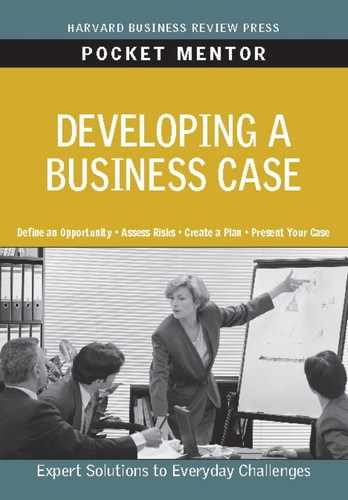What Is a
Business Case?

Perhaps you’ve been managing a project and you’ve concluded that acquiring some new software would help your company cut costs and increase efficiencies. Or maybe you want to hire several new employees or buy a new piece of equipment for your group.
You’ve presented your proposal to your boss, and he responded, “You’ll need to make the business case for it before we can consider it.”
You’re happy to oblige—but you’re not sure what, precisely, a business case consists of or how to go about creating one. You wonder, “Does he mean a business plan?” But a business case differs in important ways from a business plan. Your first step in building a case for your great idea is to understand the difference.
Business case versus business plan
A business case answers the question “What happens if we take this course of action?” For example, if your unit is considering expanding sales to a new market, your boss might ask, “Which of three alternative markets should we invest in to create the most value? And should we even make this investment?”
A business plan, on the other hand, describes how an organization or business unit intends to navigate successfully through its own unique competitive environment. Business plans feature long-range projections of revenues, expenses, business strategy, and other information. Typically, managers and executives use business plans to secure financing from investors or to plan strategy execution for an organization or business.
When you should create a business case
In many ways, the process of building a business case is similar to solving a problem. For example, suppose you don’t have enough staff to accomplish your responsibilities, or you believe that your company’s competitors use more efficient processes that allow them to have lower costs than your firm does. Developing a business case would not only help you identify potential solutions to such problems, but also help you sell your ideas to key decision makers.
A business case is useful when you want to
• Demonstrate the value a proposed product or service would generate for your organization
• Prioritize projects within your group and identify which ones to eliminate
• Demonstrate the value of a product or service to a customer to make a sale
• Obtain additional resources for a new project, initiative, or organization
• Modify an existing offering
• Invest in a new capability, such as a software program or training
• Decide whether to outsource a particular function
A complex document
As you might imagine, building a business case for a relatively simple decision—such as whether to buy a new copier for your department and, if so, which one to select—is a pretty straightforward process. When you’re making a case for a more expensive, complex course of action, however, the process requires more thought.
As you’ll discover, this book presents a fairly sophisticated example for illustrative purposes—so you can see how the entire process of creating a business case unfolds. In your role, you may not need to gather as much information as the protagonist in the example must gather, and you may not need to use complex numerical analysis. Whereas a business case similar to the example used in the topic may take ten to fifteen days to complete, a simpler business case may take only a few hours.
It’s not the plan that is important, it’s the planning.
—Dr. Graeme Edwards
Seven steps to a business case
Still, it is important to distinguish between the process of building a business case and the product you deliver to decision makers and stakeholders. The product is a document or presentation. Many organizations have their own templates and specific guidelines for how to create this product—including how to format the information, how to treat graphics, and so forth.
This book focuses on the process of defining the opportunity, identifying the alternatives, gathering the necessary information, analyzing the alternatives, and preparing to sell your ideas. After all, building a business case is about identifying and considering multiple alternatives before making a well-informed recommendation to support one option that will create value for the organization and often its stakeholders. The creation of a document or presentation is the final step in this process—and it can happen only after you’ve completed the earlier steps.
Regardless of the format of your business case, you can use the following steps to prepare it:
• Step 1: Define the opportunity. Describe the situation and the business objectives that your proposal will affect.
• Step 2: Identify the alternatives. Brainstorm multiple approaches and then choose three to four to analyze.
• Step 3: Gather data and estimate time frame. Obtain information about each alternative and estimate how long each option will take to implement.
• Step 4: Analyze the alternatives. Analyze how your options will affect the business objectives you’ve defined.
• Step 5: Make a choice and assess the risk. Make a recommendation based on your analyses, and consider how you will mitigate any risks associated with your recommendation.
• Step 6: Create a plan for implementing your idea. Identify, at a high level, how you will achieve your goals and who will be accountable for each milestone. Spell out when you expect to see benefits.
• Step 7: Communicate your case. Create a document or a presentation, or both, to sell your recommendation to decision makers.
You will need to complete each of these steps to build a strong business case. However, the depth of analysis and extent of documentation necessary to support your case will likely vary depending on the proposed initiative’s scope, costs, organizational impact, and risk.
